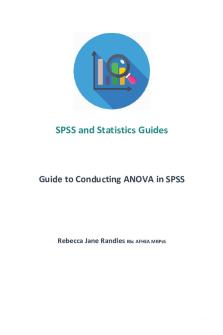T-Test In SPSS PDF

| Title | T-Test In SPSS |
|---|---|
| Course | Biological Psychology |
| Institution | University of Melbourne |
| Pages | 2 |
| File Size | 128.5 KB |
| File Type | |
| Total Downloads | 86 |
| Total Views | 136 |
Summary
T-test in SPSS...
Description
T-Test for Difference in Means: How to Do It and How to Read Results in SPSS Doing the T-Test Procedure in SPSS Start SPSS Analyze, Compare Means, Independent Samples T-Test o (Note: “Independent Samples T-test means that there are two groups, and we are comparing the means of the two groups.) Make the variable for which you want to compute a mean the “Test Variable” Make the variable that defines the two groups the “Grouping Variable” Click “Define Groups”, then enter the value that each group has on the “Grouping Variable” What to Remember: The t-test for the difference in means is an hypothesis test that tests the null hypothesis that the means for both groups are equal, versus the alternative hypothesis that the means are not equal (2-tail) or that the mean for one of the groups is larger than the mean for the other group (1-tail). To interpret the t-test results, all you need to find on the output is the p-value for the test. To do an hypothesis test at a specific alpha (significance) level, just compare the p-value on the output (labeled as a “Sig.” value on the SPSS output) to the chosen alpha level. Alternatively, you could just report the p-value, rather than reporting whether the result is statistically significant or not at an arbitrary alpha level(s).
Note: See the second page of this document to see how to read the SPSS output.
Example SPSS Output for T-Test for Difference in Means T-Test Group Statistics
WEIGHT Vehicle Weight (lbs.)
ORIGIN Country of Origin 2 European 3 Japanese
N 73 79
Mean 2431.49 2221.23
Std. Deviation 490.884 320.497
Std. Error Mean 57.454 36.059
Independent Samples Test Levene's Test for Equality of Variances
F WEIGHT Vehicle Weight (lbs.)
Equal variances assumed Equal variances not assumed
18.242
Sig. .000
t-test for Equality of Means
t
df
Sig. (2-tailed)
Mean Difference
Std. Error Difference
95% Confidence Interval of the Difference Lower Upper
3.150
150
.002
210.27
66.756
78.362
342.169
3.100
122.367
.002
210.27
67.832
75.990
344.541
How to Read this Output: Note the mean for each of the two groups in the “Group Statistics” section. This output shows that the average weight for European cars is 2431 pounds, versus 2221 pounds for Japanese cars. To see the results of the t-test for the difference in the two means, find the p-value for the test. The p-value is labeled as “Sig.” in the SPSS output (“Sig.” stands for significance level). To find the correct “Sig.”, look in the section of the “Independent Samples Test” output labeled “t-test for Equality of Means” and you will find a column labeled “Sig. (2-tailed).” This is the correct column, not the column labeled “Sig.” in the section of the “Levene’s Test for Equality of Variances” section. Finally, read the “Sig.” value in the second row, the row labeled “Equal variances not assumed”. We will use the second row since we almost never have any reason to think a priori that the amount of variation within each group will be the same (the p-value in the two rows is usually almost the same anyway). In the above example the p-value is .002, implying that the difference in means is statistically significant at the .1, .05. and .01 levels. Summary: To find the p-value for the hypothesis test for the difference in means, look in the column labeled “Sig. (2-tailed)” in the “t-test for Equality of Means” section, and in the second row (labeled “Equal variances not assumed”). Note that since the p-value given by SPSS is 2-tailed, you need to divide it in half for a 1-tailed test. In the above example the 1-tailed p-value would be .001....
Similar Free PDFs

T-Test In SPSS
- 2 Pages

Dummy VAriable in SPSS
- 4 Pages

Personality-data-in-SPSS
- 6 Pages

ANOVA Analysis in SPSS
- 12 Pages

SPSS - SPSS Zusammenfassung
- 22 Pages

Running Tests in SPSS - MR&CI
- 13 Pages

SPSS - SPSS project two, Ungvary
- 1 Pages

Assignment SPSS
- 12 Pages

SPSS - metodología
- 16 Pages

Manual SPSS
- 18 Pages

PENGENALAN SPSS
- 12 Pages

Tabelka - SPSS
- 3 Pages

SPSS Assignment - Shane Satar
- 7 Pages
Popular Institutions
- Tinajero National High School - Annex
- Politeknik Caltex Riau
- Yokohama City University
- SGT University
- University of Al-Qadisiyah
- Divine Word College of Vigan
- Techniek College Rotterdam
- Universidade de Santiago
- Universiti Teknologi MARA Cawangan Johor Kampus Pasir Gudang
- Poltekkes Kemenkes Yogyakarta
- Baguio City National High School
- Colegio san marcos
- preparatoria uno
- Centro de Bachillerato Tecnológico Industrial y de Servicios No. 107
- Dalian Maritime University
- Quang Trung Secondary School
- Colegio Tecnológico en Informática
- Corporación Regional de Educación Superior
- Grupo CEDVA
- Dar Al Uloom University
- Centro de Estudios Preuniversitarios de la Universidad Nacional de Ingeniería
- 上智大学
- Aakash International School, Nuna Majara
- San Felipe Neri Catholic School
- Kang Chiao International School - New Taipei City
- Misamis Occidental National High School
- Institución Educativa Escuela Normal Juan Ladrilleros
- Kolehiyo ng Pantukan
- Batanes State College
- Instituto Continental
- Sekolah Menengah Kejuruan Kesehatan Kaltara (Tarakan)
- Colegio de La Inmaculada Concepcion - Cebu


